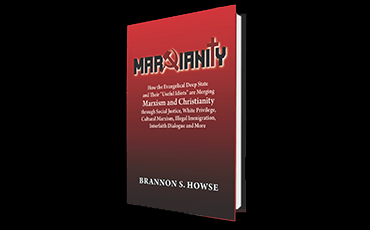The Mother/Son Cult & Why I Do Not Call it Easter But Resurrection Sunday
The article below comes from Brannon's new book The Coming Religous Reich: Exposing The Sinister Influences Sweeping The World Toward a Satantic Global Empire. 512 pages, hardcover. Click here to order now in hardcover:
http://www.worldviewweekend.com/products/books/coming-religious-reich
Click here to download as an ebook right now:
http://www.worldviewweekend.com/products/ebooks/coming-religious-reich-ebook-documentary
The concept of the Mother of Harlots was birthed at the Tower of Babel—Babylon—as described in Genesis 11. And now what kind of modern connections do we see? A recent poster promoting the European Union features a famous painting from 1563 of the Tower of Babel. The promotional theme inscribed on the poster says: EUROPE. MANY TONGUES, ONE VOICE. Here’s the scripture the theme plays off of:
Now the whole earth had one language and one speech. And it came to pass, as they journeyed from the east, that they found a plain in the land of Shinar, and they dwelt there.
Then they said to one another, “Come, let us make bricks and bake them thoroughly.” They had brick for stone, and they had asphalt for mortar. And they said, “Come, let us build ourselves a city and a tower whose top is in the heavens; let us make a name for ourselves, lest we be scattered abroad over the face of the whole earth.” (Genesis 11:1-4)
Bible readers often think this passage means the people of Shinar (modern-day Iraq) were trying to build a tower that would reach into heaven, but that’s not what the scripture says. They are not building so as to reach into heaven, the “dwelling place” of God. Rather, they are building a tower with a top “in the heavens”—up high. The city is the center of a political and economic system, and the tower represents their religious system. Does that sound familiar? The intertwining of religious, economic and political systems? The three tracks to globalism. That’s why we should not be surprised when spiritual leaders talk political and political leaders talk spiritual.
The current pope, the previous one, and the popes before, as well as Rick Warren and many other “evangelical pastors,” are spiritual leaders who talk political. And people like former British prime minister Tony Blair (a convert to Roman Catholicism) are politicians who talk spiritual.
In June 2009, for instance, Pope Benedict XVI issued a 30,000-word encyclical calling for reform of the United Nations so there could be true world political authority. He also called for a global tax to provide redistribution of wealth from rich countries to poor countries, and a worldwide redistribution of energy resources so countries lacking those resources can have access to them. What he is promoting, of course, is “sustainable development.” Sustainable development is the focus of the June 1992 Earth Summit in Rio de Janeiro, Brazil. The conference’s follow-up document, Agenda 21, offers a framework for global governance.
Its initiatives include abortion on demand, population control, nationalized health care, public housing, welfare entitlements, elimination of what we would call Second Amendment rights, reduction of parental authority, hate crime laws, and the general redistribution of wealth and elimination of free speech.
In another spiritual-leader-talking-political incident, the Vatican issued an 18-page report in October 2011 calling for a world central bank. The words “common good” were used 22 times in the report. That, of course, is a euphemism for communitarianism, the mixture of socialism with capitalism. As you can see from continuing the Genesis story, God was not pleased with this idea:
[quote] But the Lord came down to see the city and the tower which the sons of men had built. And the Lord said, “Indeed the people are one and they have all one language, and this is what they begin to do; now nothing that they propose to do will be withheld from them. Come, let Us go down there and confuse their language, that they may not understand one another’s speech.” So the Lord scattered them abroad from there over the face of all the earth, and they ceased building the city. Therefore its name is called Babel, because there the Lord confused the language of all the earth; and from there the Lord scattered them abroad over the face of all the earth. (Genesis 11:5-9) [end quote]
Remarkably, this episode takes place within a hundred years after the worldwide flood which only Noah and his sons and their wives survived. You’d think these people would have remembered the message, but it appears they’re back to being as wicked as before the flood. They’re rebelling against God (again) and saying, “We don’t need God.”
These people come from a very identifiable lineage. According to Genesis 10:6, Noah’s son Ham had a son named Cush, and Genesis 10:8 explains that “Cush begot Nimrod” and that Nimrod “began to be a mighty one on the earth.” Then, Genesis 10:10 delivers the “punch line”: “And the beginning of his kingdom was Babel . . . in the land of Shinar.”
Fortunately, we can look at some sources outside of the Bible—other historical documents—that provide more information about this phase of history. The Jewish historian Josephus is especially helpful. Josephus wrote quite a bit about the Tower of Babel and Nimrod, and he explains that one of the reasons Nimrod’s people built the Tower of Babel was that they were rebelling against God.
Nimrod’s war against God is a reminder of a more recent against-God warrior named Karl Marx. Marx wrote The Communist Manifesto in 1848. It was Marx that declared, “My object in life is to dethrone God and destroy capitalism.” Lots of people, it seems, have been waging war against God, albeit unsuccessfully, for a long time. Josephus adds a fascinating detail to his recounting of the Babel story. He explains that one reason the people of Shinar built the tower was to make it so high that flood waters would not be able to reach them. That way, if God were to change His mind and destroy the earth using a flood again, these folks could pat themselves on the back and say, “We’ve outsmarted you this time, God. We’ve got a tower so high that the flood waters won’t reach up here.”
A Strange Mix
To give you “the rest of the story,” the mythology that developed around Nimrod reveals much of the heart of this religious system. According to the story concocted by his wife Semiramis, Nimrod dies and travels to the sun to become the sun god. Her goal in “deifying” her husband was that she, the queen of Babylon, wanted to retain her power. So, she tells the people Nimrod has become the sun god and has impregnated her via a sunbeam. It’s a virgin birth of sorts, but she is not a virgin. In fact, Semiramis was a seriously immoral person. Tammuz, the child born to Semiramis, is said to be the reincarnation of Nimrod.
At this point in the Babylonian myth, Tammuz is considered to be god incarnate and becomes the object of great worship. Later, he is killed, according to mythology, by a wild boar, and Semiramis weeps for her son for 40 days. Then he is resurrected. This takes place in the early spring, right around “Easter.” The timing, unfortunately, provides the source of our word Easter. The term comes from the name Ishtar, the Babylonian god of fertility.
Much of what we use to celebrate Christmas and Easter stems from paganism—mistletoe, for instance—and even Valentine’s Day and Cupid. Such facts bring up another question, often debated these days: Should we not celebrate Christmas or the resurrection of our Lord because of the pagan roots of many aspects of the festivities? And this is how I respond to the many people who call my radio program with that question: I’m not about to let the pagan world stop me from celebrating the birth of Jesus Christ, my Lord and Savior. Absolutely not. If you want to celebrate on December 25, that’s up to you; that’s when most people do. But if you understand that to be related to a pagan date connected with the Babylonian cult and don’t want to celebrate on December 25, you don’t have to. The point is: if I choose to observe the Lord’s birth on December 25 for godly reasons, I’m not going to let the culture stop me from acknowledging, celebrating, and rejoicing in the birth of my Lord and Savior Jesus Christ.
The same goes for Resurrection Sunday. I don’t call it Easter; I call it Resurrection Sunday because I don’t want to acknowledge the god Ishtar, the fertility god. And by the way, the reason there is an Easter Bunny and Easter eggs is to symbolize fertility. But I am certainly going to celebrate Resurrection Sunday. Similar to the Christmas issues, if you don’t want to do this when it fits in with the pagan calendar and the pagan rituals and the timing of the changing of the seasons, I believe that’s fine. With that being said, we have to understand that much of what we see today comes from the pagan religions going all the way back to the Tower of Babel.
The history of the name Semiramis also adds a twist to our strange intermingling of pagan practices. In the Bible, she was also referred to as Ashteroth. Other names include:
- The Queen of Babylon
- Venus
- Aphrodite
- Diana
- Isis
- Gaia
- Mother Nature
- Queen of Heaven.
About that last phrase, “Queen of Heaven”: The Roman Catholic Church uses it in reference to Mary the Mother of Jesus, even though the Bible uses it only in reference to Ishtar (see Jeremiah 7:18; 44:17-19, 25).
But why these different names? Again we look at the Tower of Babel for the answer. When God confused the language of the people, they took this mother-son cult of Semiramis and Tammuz and spread it throughout the world, but in different languages. One version of the names is Isis and Horus. The Walters Art Museum in Baltimore houses a statue of the two of them, dated from 680 to 640 B.C. This means the Egyptians developed a mother-son image nearly seven centuries before Jesus was born.
Satan took a counterfeit story and made it line up with the story of what was to come—he knew Christ would eventually come because Genesis foretells the Messiah who will crush the head of Satan. Sadly, many people have turned away from Christianity because of these mythologies, thinking the truth of Christ is just one more version of these demonic narratives, and that’s exactly what Satan wants. The internet is full of stories of people who have rejected Christianity for this very reason. They say, “Hey, Christianity is nothing more than paganism, but they have Christianized it.” But I say: “No, no, no! Satan has taken Christianity and connected it to paganism to try to undermine it.” Satan always twists the truth to try to destroy it in the minds of people.
Next, we need to see exactly how he’s managed this sleight of hand with Mary and Jesus in Christianity. The mother-son cult birthed at the Tower of Babel goes by many names, but the original mother, Semiramis, is not the only one whose names have many variations, thanks to the multiplicity of languages.
The above comes from Brannon's new book The Coming Religous Reich: Exposing The Sinister Influences Sweeping The World Toward a Satantic Global Empire. 512 pages, hardcover. Click here to order now in hardcover:
http://www.worldviewweekend.com/products/books/coming-religious-reich
Click here to download as an ebook right now:
http://www.worldviewweekend.com/products/ebooks/coming-religious-reich-ebook-documentary
Support Our Broadcast Network
Trending Stories
Latest
We're a 100% Listener Supported Network
3 Simple Ways to Support WVW Foundation
Make Monthly Donations
-or-
A One-Time Donation
-
Mail In Your Donation
Worldview Weekend Foundation
PO BOX 1690
Collierville, TN, 38027 USA -
Donate by Phone
901-825-0652



















